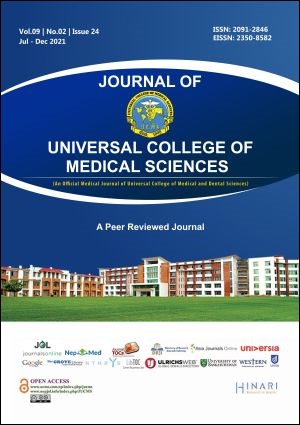An Emerging, Neglected and Underestimated Zoonotic Parasitic Ocular Infestation: A Comprehensive Review on Thelaziasis
DOI:
https://doi.org/10.3126/jucms.v9i02.42020Keywords:
Ocular infestation, Thelaziasis, Thelazia callipaeda, ZoonoticAbstract
Human thelaziasis is an emerging insect-borne zoonotic ocular parasitic infestation, occur more commonly in rural communities with poor living and low socioeconomic living, and mainly affects the children and old age people, where humans live in close proximity with animals. Human thelaziasis is caused by both Thelazia callipaeda and Thelazia californiensis. T. callipaeda lives under the eye lids, nictitating membranes, orbit, conjunctival sac, lachrymal glands, and lacrimal ducts of cats, dogs, rabbits, horses, cattle, deer, badgers, monkeys, wolves, foxes (definitive hosts) and man being an accidental host. The vectors (intermediate hosts) are non-biting, tear-seeking, diptera flies of family Drosophilidae (fruit flies) Phortica variegata, which feeds on tears of their definitive hosts, including humans. Clinical manifestations include conjunctivitis, lacrimation, itching or pain with foreign body sensation, epiphora, follicular hypertrophy, and less often with severe signs and symptoms such as keratitis, photophobia, ectropion, corneal opacities (due to the migration of worm across the cornea), floaters within the eye chamber leading to visual impairment/blindness. The knowledge and scientific information on human thelaziasis is still unknown or relatively limited to many ophthalmologists and clinicians, and received little attention; hence this comprehensive and systematic review of human thelaziasis, is undertaken to highlight its importance and further research.
Downloads
Downloads
Published
How to Cite
Issue
Section
License
Copyright (c) 2021 Journal of Universal College of Medical Sciences

This work is licensed under a Creative Commons Attribution-NonCommercial 4.0 International License.
Authors have to give the following undertakings along with their article:
- I/we declare that this article is original and has not been submitted to another journal for publication.
- I/we declare that I/we surrender all the rights to the editor of the journal and if published will be the property of the journal and we will not publish it anywhere else, in full or part, without the permission of the Chief Editor.
- Institutional ethical and research committee clearance certificate from the institution where work/research was done, is required to be submitted.
- Articles in the Journal are Open Access articles published under the Creative Commons CC BY-NC License (https://creativecommons.org/licenses/by-nc/4.0/)
- This license permits use, distribution and reproduction in any medium, provided the original work is properly cited, and it is not used for commercial purposes.




